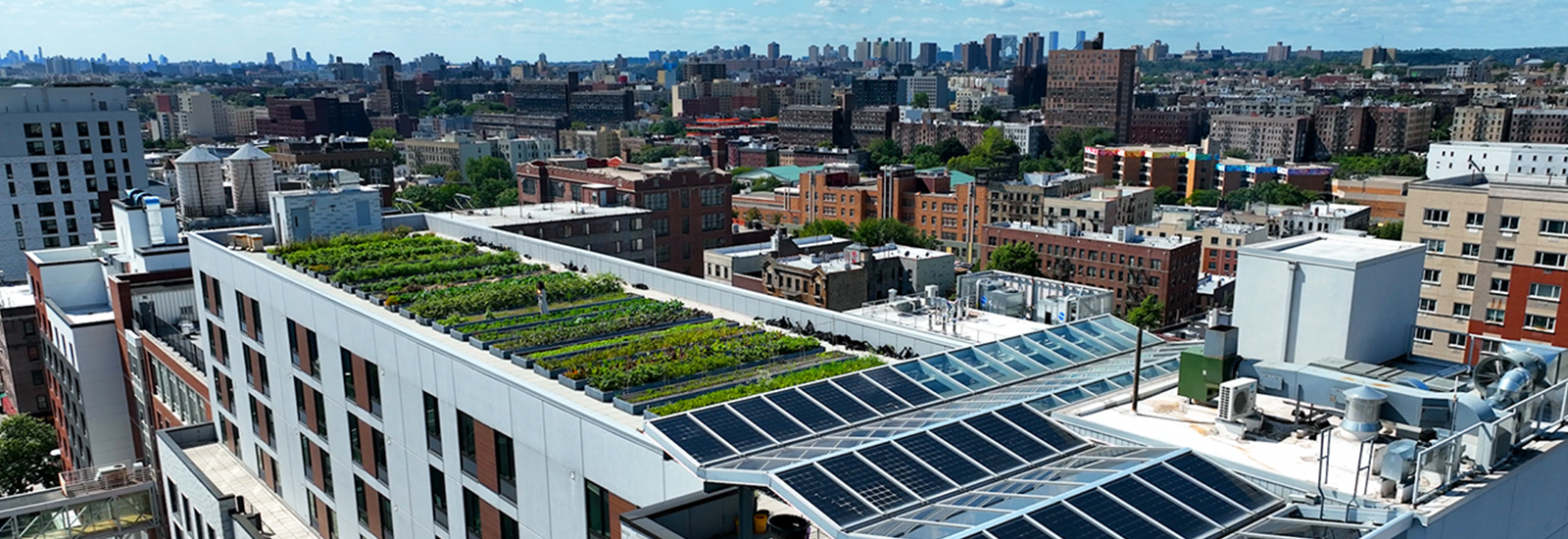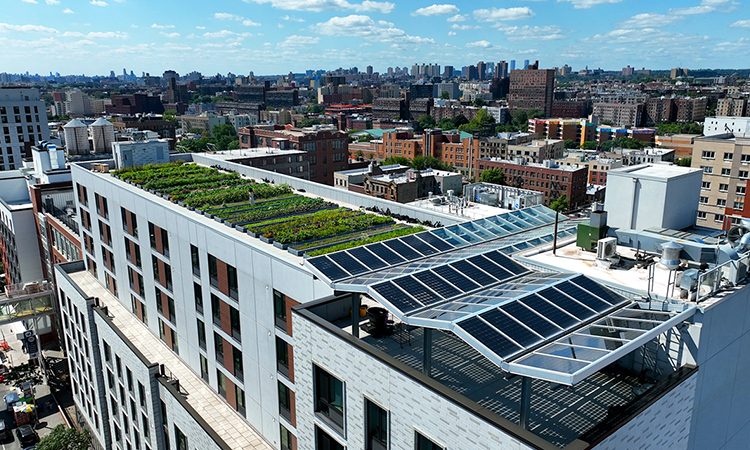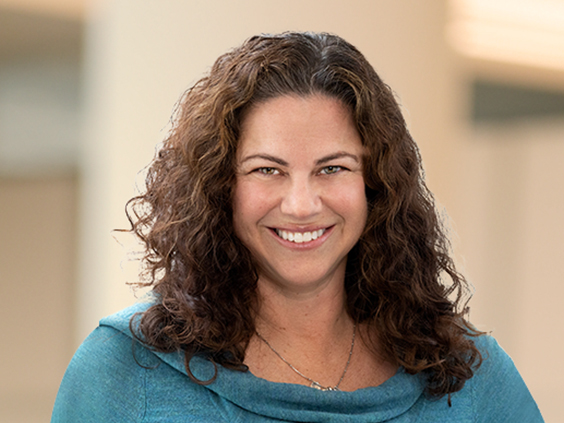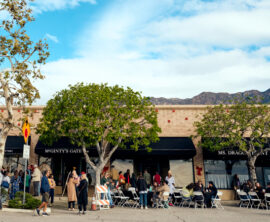Key takeaways
- Cooper Gardens housing development in New York City offers sustainable living features such as rooftop solar panels, ENERGY STAR appliances, and advanced air filtration systems.
- Wells Fargo provided significant funding, including a $67 million Low-Income Housing Tax Credit (LIHTC) and a $72 million Letter of Credit.
- On-site supportive social services include case management and financial, educational, and vocational resources through BronxWorks.
- 30% of the 314 affordable units are dedicated to formerly homeless households.
- On-site garden produces more than 230 pounds of vegetables weekly during the growing season, with 60% distributed to the community through a pantry.
At the Cooper Gardens housing development in the Bronx, summer is when the amenities shine. There’s fresh produce from the on-site garden, rooftop solar panels taking in the sunlight, and an apiary abuzz with bees.
“It looks beautiful,” said Maria Perez, who has lived in Cooper Gardens for four years. “It’s the perfect place to raise my three boys.”
The development is a far cry from its origins as the parking lot for St. Barnabas Hospital. It’s the realization of the hospital’s chief clinical and strategy officer, Dr. Manisha Kulshreshtha, and her team who aspired to create a place where the community is well fed, well looked after, and receives support to foster a brighter future. “We wanted to make sure this community was able to survive and live here,” said Kulshreshtha.
[Video overview: Elaine Braithwaite, Senior Director for New Construction at L+M Development Partners; Dr. Manisha Kulshreshtha, SVP Chief Clinical and Strategy Officer at St. Barnabas Hospital; Linda Goode Bryant, Founder and President of Project EATS; Cooper Gardens Resident Maria Perez; Shanice John, Program Director at BronxWorks; and Korbin Heiss, Managing Director, Community Lending and Investment at Wells Fargo talk about the impact of the Cooper Gardens housing development. The development at St. Barnabas Hospital provides underserved communities with access to fresh produce, solar energy, and a rooftop beehive.]
[Music]
[Elaine Braithwaite, Senior Director for New Construction, L+M Development Partners]
Before all of this, this whole site was kind of an open parking lot. It’s always really great just to see, you know, going from that to, this whole multipurpose project. The Cooper Gardens Project has been a long-time collaboration between Saint Barnabas Hospital, L&M, where they’d be creating this new state-of-the-art health and wellness facility.
[Dr. Manisha Kulshreshtha, SVP Chief Clinical and Strategy Officer, St. Barnabas Hospital]
When we first started this, I think this was a vision of our institution to make sure that our community is well fed, well looked after, and stays healthy. Also, we made sure there were solar panels on top. I think making sure that we’re sustainable is such an important part to this building.
[Braithwaite]
L&M is a triple bottom-line company, and sustainability is at the forefront of the projects we develop. We use ENERGY STAR appliances, low VOC paints, and just tried to make the building as sustainable as possible.
[On-screen text]
The building rated 99 out of 100 on the Environmental Protection Agency’s ENERGY STAR Portfolio Manager.
[Kulshreshtha]
We have a rooftop garden.
[Linda Goode Bryant, Founder and President, Project EATS]
The idea was to have food growing on the roof and have community programs that help to support residents eating healthy, nutritious, plant-based food.
[On-screen text]
230+ lbs. of vegetables are produced weekly during the growing season.
60% is given out to the community weekly through a pantry.
[Braithwaite]
We also really thought it was so critical and so great if we could marry the wellness center with affordable housing.
[Maria Perez, Cooper Gardens Resident]
When I got pulled to live here, I’d seen how the apartment looks. It looks beautiful and it’s the perfect place to raise the boys.
[Kulshreshtha]
We did not want to gentrify this neighborhood and displace anyone from here. We wanted to make sure that this community was able to survive and live here.
[Braithwaite]
Overall, the project has 314 units of affordable housing, and within the affordable housing, we were really excited to be able to provide 95 units of supportive housing through a partnership with BronxWorks.
[On-screen text]
314 total affordable housing units.
95 formerly homeless household units.
[Shanice John, Program Director, BronxWorks]
BronxWorks is a large organization. They provide a lot of everything for residents We want to keep all of our households off the street or out of shelter. We want to make sure everyone has a stable home.
[Korbin Heiss, Managing Director, Community Lending and Investment, Wells Fargo]
I think it’s kind of basic. Studies have shown that living in a stable, affordable home results in stronger outcomes for children, youth, and adults. So while it sounds like a platitude, it’s really an investment in all of us.
[Braithwaite]
We’re so grateful for our partnership with Wells Fargo. We think it’s so critical for partnerships like this to happen so that we’re able to develop these kind of large-scale, complex, mixed-use projects like St. Barnabas. You know, it took a lot of years, but we were so excited to create this project.
[Kulshreshtha]
Our whole mission is to prevent our patients from getting into the hospital. I know it sounds weird for me as a provider and a physician to say that we don’t want them in a hospital, but we want them healthy. That’s our goal.
© 2023 Wells Fargo Bank, N.A. All rights reserved.
Watch the video (2:34): See how affordable housing built with state-of-the-art sustainability has a meaningful impact on Cooper Gardens residents and the whole community.
Credit: William Gallego
Sustainable features at Cooper Gardens:
- 1,000-square-foot solar shade canopy with 13kW total potential output
- Advanced air filtration
- ENERGY STAR appliances
- Garden nursery structure with 40% recycled aluminum framing that’s 100% recyclable
- Low-VOC (volatile organic compounds) paint
Blending sustainable housing with support services
Completed in 2019, Cooper Gardens is a $156 million, 450,000-square-foot, multifamily-building, mixed-use project at the intersection of housing affordability and sustainability. “Sustainability is at the forefront of the projects we develop,” said Elaine Braithwaite, senior director for new construction at L+M Development Partners.
St. Barnabas worked with L+M Development Partners to create the modern, urban refuge. It’s equipped with rooftop solar arrays, ENERGY STAR appliances, advanced air filtration, and other sustainable living features. The building rated 99 out of 100 on the Environmental Protection Agency’s ENERGY STAR Portfolio Manager.
“Sustainability is definitely a priority in the affordable housing industry,” said Korbin Heiss, managing director in Wells Fargo’s Community Lending and Investment group. “What’s exciting about this project is that it blends the related elements of health, housing, and sustainability.”
Wells Fargo combined a sustainable loan structure with a $67 million Low-Income Housing Tax Credit (LIHTC) and a $72 million Letter of Credit to finance the construction. “We’re so grateful for our partnership with Wells Fargo,” Braithwaite said. “It’s critical for partnerships like this to happen so that we’re able to develop large-scale, complex, mixed-use projects like at St. Barnabas.”
Creating opportunities for underserved communities
At Cooper Gardens, 30% of the 314 affordable units are dedicated to formerly homeless households. BronxWorks, a nonprofit organization, provides on-site supportive social services, including case management and financial, educational, and vocational resources.
“Affordable housing that comes with support helps ensure that no one has to face eviction or be back on the street,” said BronxWorks’ Shanice John, a licensed social worker and Cooper Gardens supportive housing program director. “They can come down to the office to meet with their case manager or talk to someone who can help them with their lease, scheduling appointments, or enrolling their children in school,” she said. “That kind of on-demand support is really beneficial.”
Studies have shown that living in a stable, affordable home results in stronger outcomes for children, youth, and adults. “Thriving families result in thriving communities in neighborhoods, and ultimately a thriving city,” said Heiss. “It’s really an investment in all of us.”
Wells Fargo works closely with experienced multifamily market-rate and affordable housing developers and investors, as well as mission-oriented for-profits and not-for-profits and Community Development Financial Institutions (CDFIs) that are focused on affordable housing and economic development.

Cooper Gardens affordable and sustainable housing development thrives with financing by Wells Fargo, and support from Project EATS and BronxWorks.
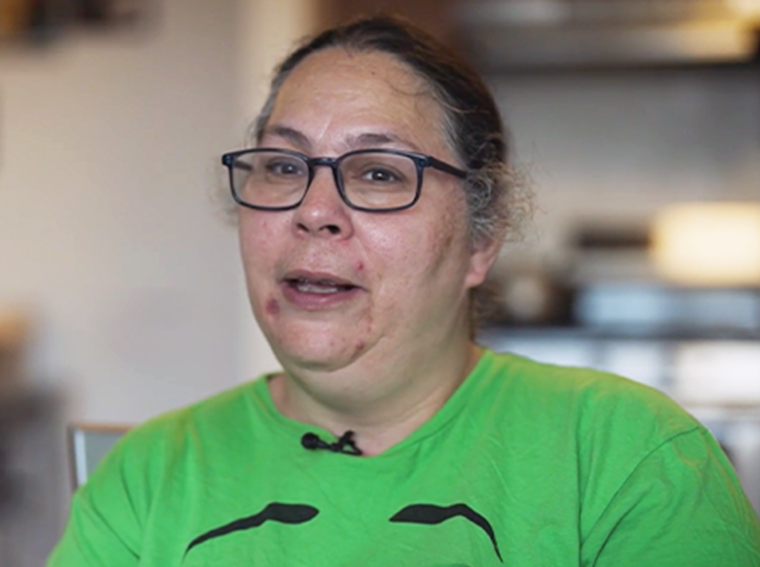
Cooper Gardens resident Maria Perez
Filling prescriptions for fresh produce
The Cooper Gardens on-site garden is helping to nourish residents providing vegetables like peppers, tomatoes, zucchini, eggplants, and leafy greens.
“When I first moved in, it was wonderful. It was so wonderful,” resident Maria Perez said. “I feel like I’m in my own world.”
Of the 230+ pounds of vegetables produced weekly during the growing season, 60% is given out to the community through a pantry. “We work with food insecure communities throughout New York City. The primary benefit is access to fresh, nutritious, healthy food grown right where people live,” said Linda Goode Bryant, founder of Project EATS. “We fill food prescriptions that doctors prescribe for their patients. It is really exciting that we’re working with a hospital doing that.”
Heiss adds, “Food is so importantly linked to health. Housing, food, schools, green space are all part of the bundle of goods and services that I believe is critical to creating communities that thrive.”
More ways The Bank of Doing supports affordable and sustainable housing solutions
In 2022, Wells Fargo’s Inclusive Communities and Climate Bond allocated $840.4 million to support more than 3,500 affordable units across 10 states. This is in addition to philanthropic efforts, which include:
- Project Homekey Accelerator Grants is a program that allowed the state of California and its housing partners to buy and renovate hotels and other sites to combat the state’s homelessness crisis.
- 90 Sands, a former hotel in New York City, was turned into 491 units of affordable and supportive housing with the help of a $3 million lead grant from Wells Fargo.
- An estimated 1,600 affordable homes will be developed between 2022 and 2027 by the Housing Partnership Network’s Adaptive Reuse Accelerator Program, which the Wells Fargo Foundation funds.
- The Wells Fargo Foundation’s Housing Affordability Breakthrough Challenge offers $1 million to $3 million grants to the winning groups innovating the development of affordable housing in the areas of finance, construction, and resident services.
- A $3.15 million Wells Fargo grant will enable Chicago nonprofit Elevate to decarbonize 100 homes for low- and moderate-income residents.
Read more about sustainable finance
- The Wells Fargo Institute for Sustainable Finance
- How services and amenities could play a life-changing role in affordable housing
- This invention could reduce the carbon footprint of old buildings without displacing residents
FAQs
Sustainable finance can play a pivotal role in alleviating the critical affordable housing shortage. Sustainable loans are financial tools that support the development of homes that are both environmentally responsible and affordable for low- to moderate-income households. They help fund energy-efficient buildings, clean energy upgrades, and climate-resilient infrastructure while expanding access to safe, healthy housing. They often leverage public incentives and partnerships with nonprofits to reduce emissions and improve long-term affordability.
At New York’s Cooper Gardens, sustainable loans were instrumental in transforming a former hospital parking lot into a vibrant, mixed-use affordable housing community. Through a combination of $67 million in Low-Income Housing Tax Credit (LIHTC) equity and a $72 million Letter of Credit from Wells Fargo, the project delivered:
- Sustainable and resilient infrastructure: Rooftop solar panels, ENERGY STAR-certified appliances, advanced air filtration systems, and a roof garden producing over 230 pounds of vegetables weekly.
- Supportive services: On-site case management, financial counseling, and vocational training to help residents stabilize and thrive.
- Housing for vulnerable populations: 30% of the 314 units are reserved for formerly homeless households, integrating permanent supportive housing into a broader affordable housing strategy.
Cooper Gardens is a great example of how sustainable loans can do more than just fund construction; they help build stronger, healthier communities. With flexible financing and support from public programs, these loans make it possible to create housing that’s affordable, environmentally responsible, and designed to support residents’ well-being.
Low-Income Housing Tax Credit is a federal program that incentivizes private investment in affordable housing by offering tax credits to developers who build or renovate homes for low-income families. When paired with environmental and social goals, LIHTC becomes a powerful tool for sustainable financing, helping create housing that’s energy-efficient, climate-resilient, and designed to support the health and well-being of the community.
Sustainable loans can reduce long-term operating costs and unlock financial incentives that offset upfront expenses:
- Projects may qualify for green premiums or lower interest rates if they meet sustainability benchmarks.
- Developers can access federal and state grants to subsidize energy-efficient upgrades.
- Tax credits such as LIHTC paired with philanthropic support can reduce the net cost of construction, especially in mixed-use or adaptive reuse projects.
While sustainable features may increase initial costs, the overall financial package — including incentives, grants, and reduced utility expenses — can make the project more cost-effective over time.
